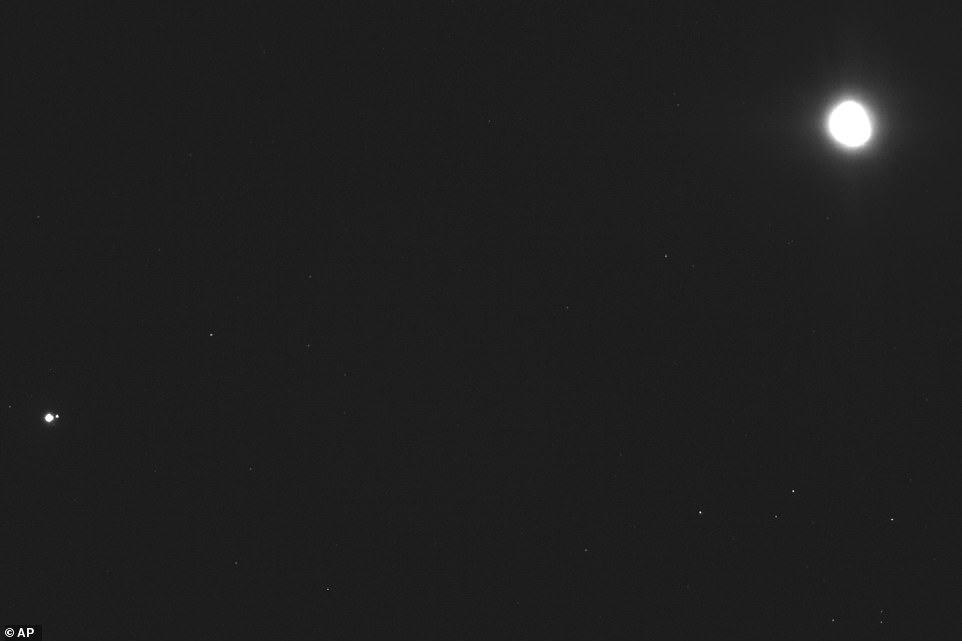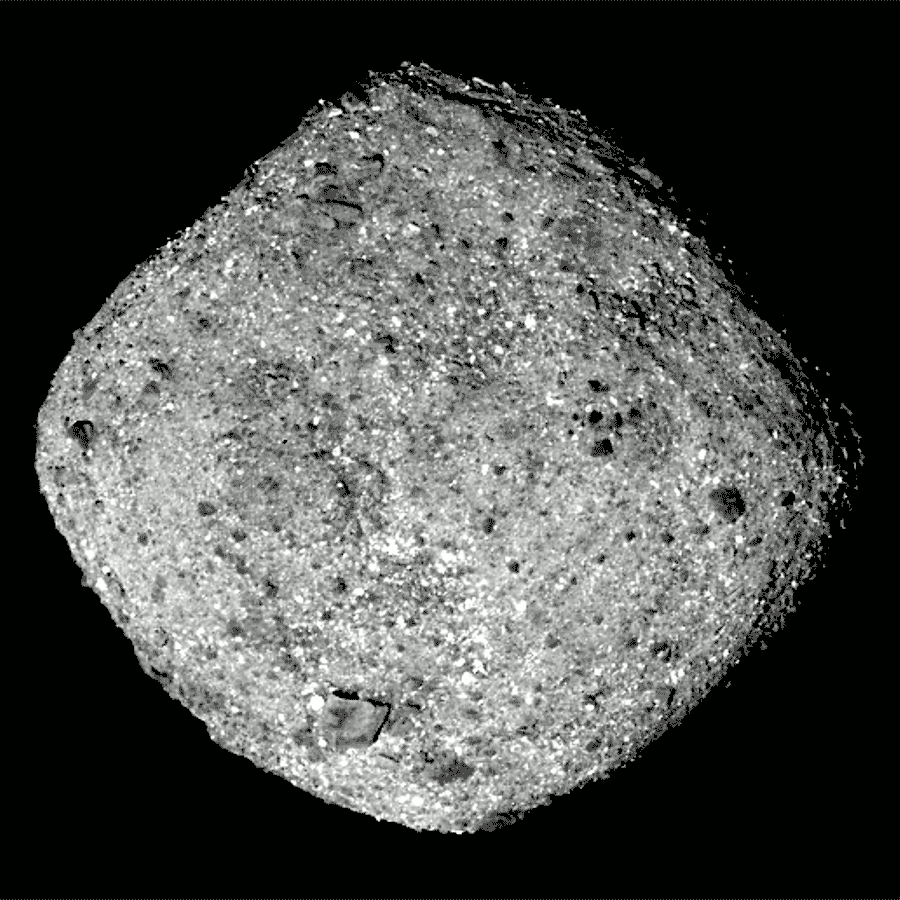
- NASA’s OSIRIS-REx spacecraft launched from Cape Canaveral in Sept 2016 on mission to asteroid Bennu
- Object is said to be carbon-rich hunk of rock that may contain organic materials, molecular precursors to life
- Scientists estimate the asteroid formed roughly 4.5 billion years ago, and is left over from early solar system
- Osiris-Rex’ ultimate goal is to bring back a dirt and rock sample of at least 2.1 ounces, to be studied on Earth
- It will survey the surface for a year before dropping down to collect sample, with plans to return home in 2023
An asteroid-circling spacecraft has captured a unique snapshot of home.
NASA’s Osiris-Rex spacecraft took the picture days before going into orbit around asteroid Bennu on New Year’s Eve.
The tiny asteroid – barely one-third of a mile (500 meters) across – appears as a big bright blob in the long-exposure photo released last week.
Seventy million miles (110 million kilometers) away, Earth appears as a white dot in the lower left, with the moon an even smaller dot but still clearly visible.
‘Despite the spacecraft’s distance from home Earth and the Moon are visible in the lower left due to the long exposure time used for this image (five seconds),’ the mission website says.
When it was taken, the spacecraft’s range to Bennu is only about 27 miles (43 kilometers), so the asteroid appears highly overexposed in the upper right.
The head of the constellation Hydra is also visible in the lower right portion of the image.
Osiris-Rex is the first spacecraft to orbit such a small celestial body, and from such a close distance – about a mile (1,600 meters) out.
Next year, Osiris-Rex will attempt to gather some samples from the carbon-rich asteroid, for return to Earth in 2023.
Osiris-Rex launched from Florida in 2016, and entered around the asteroid Bennu, 70 million miles (110 million kilometers) from Earth on New Year’s Eve
It’s the smallest celestial body ever to be orbited by a spacecraft.
Bennu is just 1,600 feet (500 meters) across.
The spacecraft’s laps are barely a mile (1.6 kilometers) above the asteroid’s surface, another record.
NASA’s OSIRIS-REx spacecraft has found water locked deep inside the asteroid it hopes to bring a sample from back to Earth.
The craft finally arrived at asteroid Bennu last month, more than two years after blasting off from Cape Canaveral Air Force Station.

Now, NASA says it ‘made the right decision’ choosing its target.
‘Recently analyzed data from NASA’s Origins, Spectral Interpretation, Resource Identification, Security-Regolith Explorer (OSIRIS-REx) mission has revealed water locked inside the clays that make up its scientific target, the asteroid Bennu,’ NASA said.
‘The presence of hydrated minerals across the asteroid confirms that Bennu, a remnant from early in the formation of the solar system, is an excellent specimen for the OSIRIS-REx mission to study the composition of primitive volatiles and organics,’ said Amy Simon, OVIRS deputy instrument scientist at NASA’s Goddard Space Flight Center in Greenbelt, Maryland.
‘When samples of this material are returned by the mission to Earth in 2023, scientists will receive a treasure trove of new information about the history and evolution of our solar system.
While Bennu itself is too small to have ever hosted liquid water, the finding does indicate that liquid water was present at some time on Bennu’s parent body, a much larger asteroid.
During the mission’s approach phase, between mid-August and early December, the spacecraft traveled 1.4 million miles (2.2 million km) on its journey from Earth to arrive at a location 12 miles (19 km) from Bennu on Dec. 3.
During this time, the science team on Earth aimed three of the spacecraft’s instruments towards Bennu and began making the mission’s first scientific observations of the asteroid.
OSIRIS-REx is NASA’s first asteroid sample return mission.
Data obtained from the spacecraft’s two spectrometers, the OSIRIS-REx Visible and Infrared Spectrometer (OVIRS) and the OSIRIS-REx Thermal Emission Spectrometer (OTES), reveal the presence of molecules that contain oxygen and hydrogen atoms bonded together, known as ‘hydroxyls.’
The team suspects that these hydroxyl groups exist globally across the asteroid in water-bearing clay minerals, meaning that at some point, Bennu’s rocky material interacted with water.
While Bennu itself is too small to have ever hosted liquid water, the finding does indicate that liquid water was present at some time on Bennu’s parent body, a much larger asteroid.
One outlier from the predicted shape model is the size of the large boulder near Bennu’s south pole.
The ground-based shape model calculated this boulder to be at least 33 feet (10 meters) in height.
Preliminary calculations from OCAMS observations show that the boulder is closer to 164 feet (50 meters) in height, with a width of approximately 180 feet (55 meters).
Bennu’s surface material is a mix of very rocky, boulder-filled regions and a few relatively smooth regions that lack boulders.
However, the quantity of boulders on the surface is higher than expected.
OSIRIS-REx will spend the next year in orbit around its target before dropping down briefly so it can get close enough to scoop up a sample of dirt and rock from the surface.
‘Our initial data show that the team picked the right asteroid as the target of the OSIRIS-REx mission. We have not discovered any insurmountable issues at Bennu so far,’ said Dante Lauretta, OSIRIS-REx principal investigator at the University of Arizona, Tucson.
‘The spacecraft is healthy and the science instruments are working better than required. It is time now for our adventure to begin.’
‘We have arrived,’ technicians announced, spurring high-fives and clapping around the control room.
Just days ago, Osiris-Rex flexed its mechanical arm through a full range of motion for the first time in space ahead of reaching Bennu; eventually, this instrument will be used to pluck a regolith sample from the surface to bring back home.
The craft has now traveled more than a billion miles since launching in September 2016.
Osiris-Rex’ ultimate goal is to bring back a regolith sample of at least 2.1 ounces. It will first survey the asteroid’s surface for a year, before selecting a safe and ‘scientifically interesting’ location to scoop up some rocks.
If all goes well, the craft will bring the sample back to Earth in September 2023.
Osiris-Rex has been sending back photos throughout the course of its journey, revealing glimpses at its then-faraway target and even our own planet from millions of miles way.
In August, the craft snapped its first image of asteroid Bennu.
While the blurry snapshot might not look like much, its first look was the closest we’ve come to the space rock yet, at 1.4 million miles away.
The craft also captured a look at Earth and moon in their ‘orbital dance’ back in January.
Asteroid Bennu, which Osiris-Rex will spend the next few years studying, is said to be a carbon-rich hunk of rock that might contain organic materials or molecular precursors to life.
‘Analyzing a sample from Bennu will help planetary scientists better understand the role asteroids may have played in delivering life-forming compounds to Earth,’ NASA explains.
‘We know from having studied Bennu through Earth- and space-based telescopes that it is a carbonaceous, or carbon-rich, asteroid. Carbon is the hinge upon which organic molecules hang.
‘Bennu is likely rich in organic molecules, which are made of chains of carbon bonded with atoms of oxygen, hydrogen, and other elements in a chemical recipe that makes all known living things.
‘Besides carbon, Bennu also might have another component important to life: water, which is trapped in the minerals that make up the asteroid.’
Once Osiris is ready to collect a sample, it will drop down closer to Bennu and hover over the surface like a hummingbird, with only its mechanical arm getting close enough to touch the asteroid.
The Touch-and-Go Sample Acquisition Mechanism (TAGSAM) will suck up the regolith, kicked up by its nitrogen gas thrusters, and hopefully collect enough to study back at home.
Scientists estimate the asteroid formed roughly 4.5 billion years ago.
‘Bennu is a leftover fragment from the tumultuous formation of the solar system,’ NASA says.
‘Some of the mineral fragments inside Bennu could be older than the solar system. These microscopic grains of dust could be the same ones that spewed from dying stars and eventually coalesced to make the Sun and its planets nearly 4.6 billion years ago.’























